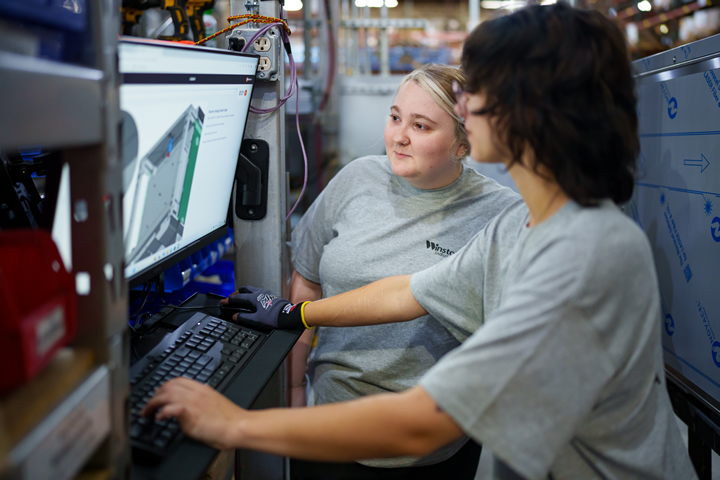Empowering the Next Generation of Manufacturing: How Digital Innovation is Shaping the Future Workforce

Throughout history, manufacturing has evolved through multiple industrial revolutions, each ushering in a new change in the factory workforce. The latest change started in the late 1960s when the industry became a solid option for Baby Boomers to reach the middle class. Today, Boomers still make up the majority of the industry's workforce, but as that generation quickly approaches retirement, their inevitable departure looms as a major disruption to the sector.
By 2033, an estimated 3.8 million new factory workers will be needed to fill the gap – but half of these positions risk going unfilled. Without attracting and securing talent to replace retiring Baby Boomers, our domestic supply chain will struggle to meet rising demands for production, quality, and efficiency. Gen X and Millennials are unlikely to fill the gap, as there has been an emphasis on securing a college degree and moving into white-collar professions with these generations.
All that said, this is not an issue of who wants to work where, it is also a population issue that can’t be fixed unless you have a DeLorean with a flux capacitor. There are simply fewer people between the ages of 18-62 in the workforce than there were yesterday – and that trend is continuing to go down more every year until around 2031.
Industry leaders need to attract and retain a new generation of factory workers: Gen Z. The challenge is that interest from Gen Z in manufacturing careers is low, with only 14% considering a career in industrial work. They are also typically technology-reliant, with limited hands-on mechanical experience. Fortunately, there is a continued shift to technology and automation in manufacturing that could be the key to attracting this new labor pool.
At the same time, manufacturers must tread lightly. Digital transformation needs to meet the skills and match the pace of Boomers, who still represent the largest population of the workforce and aren’t out of the picture yet. By embracing modern digital solutions that focus on bridging the gaps between generations, the manufacturing sector can once again become a vibrant and essential career path for future generations and reduce the probability of an existential manufacturing labor crisis.
Who we are and why we are adapting to younger generation expectations
Winston Industries started through a friendship and handshake with Colonel Sanders of KFC and grew into a global organization that provides products for the largest restaurant chains and world-class chefs. As CEO, I recognize that people are still our biggest asset. As we continue to lose great employees to retirement – which should be a truly happy moment – we are faced with immense pressure to attract, train, and retain new talent. It’s clear that a different mindset is required to accomplish that with Gen Z.
While factory leaders can use creative methods to get Gen Z workers in the door, they are unlikely to stay in a work environment that has yet to embrace digital transformation. In other words, the first step in attracting Gen Z is replacing traditional paper-based factory processes with technologies that streamline operations and make training quick and relatively painless.
Winston Industries started out by digitizing work instructions with a product called Pico MES, and by leveraging these advancements, we’ve successfully cultivated young talent and made manufacturing a viable path for a long-term career at Winston. Now, half of our workforce consists of Gen Z and Millennials, well above the industry average – and they seem to actually be staying. Our culture of authenticity is a big part of that, but so are the tools. But what do these tools look like on the factory floor?
From outdated practices to dynamic solutions
A successful multi-generational workforce starts by using intuitive technology solutions to create a workplace where everyone can thrive. One of the quickest initial wins is integrating easy-access digital work instructions into factory floor operations. This strategy not only helps foster teamwork amongst all generations, creating a more collaborative and exciting environment, but also better provides workers a tool to increase quality and efficiency – ensuring accuracy and consistency across the assembly line.
Digital work instructions allow workers to circulate and quickly onboard into new positions, providing the learning opportunities Gen Z employees crave while allowing them to work at their own pace. It reduces the dependency on tribal knowledge, maintains quality, and actually speeds up training for new hires. It is also making job rotations far easier. For many Gen Z operators, it “gamifies” manual assembly processes, with employees racing to beat assembly times of themselves or a coworker just as they would playing video games.
These technologies also provide a tremendous benefit to Baby Boomers who’d rather focus on their work instead of investing precious time training the 50th person on how to assemble a widget. In turn, supervisors and managers can spend more time on product output, efficiency, and quality. They may even get to focus more on employee development. Overall, it increases employee engagement and makes everyone’s day-to-day a little bit better. Our digital solutions have given tenured team members more freedom to adapt to changes while creating a more supportive environment for newcomers.
The response from our Baby Boomers employees has been astounding. One veteran employee recently told me our digital instructions “make it so much easier to do things the right way; I just wish we could have had it years ago.” Another worker who’s just a few years from retirement recently said to me, “When I came in, I was trained by fear…by a 50-something-year-old woman who insisted on things being done exactly her way. Now I’m using Pico MES a lot with our new products. There isn’t anyone that can tell me how we’ve always done it.” Our digital solutions have given tenured team members more freedom to adapt to changes while creating a more supportive environment for newcomers.
At the end of the day, our digitization journey hasn’t sacrificed quality, efficiency, or our bottom line – they are actually getting better. Through our MES digital work instructions, we’ve embedded error-proofing capabilities throughout our factory. Not only does every team member have a clearer understanding of each production step, but our technology can track the process for every nut, bolt, and part assembled, catching and eliminating errors at the source to prevent costly delays. We are far from perfect, but utilizing MES is allowing us to move from processes to systems, while gaining the intangible wins along the way.
Charting the path forward
Factory leaders who accept the “it's the way we’ve always done it” mentality will continue to struggle with getting new talent and will likely see a negative impact on output, quality, and costs. Those who invest in tech-savvy solutions will do a better job securing younger talent and will likely distinguish themselves from the competition. It still may not be easy, but the route to success is far more clear.
Now is the best time to prioritize these investments to attract talent for the future while still leveraging the more tenured talent that you already have. Multigenerational factory technology can help bridge digital divides, foster a sustainable industry for the future, and may even allow others to see manufacturing as a career opportunity once again.
Comments (0)
This post does not have any comments. Be the first to leave a comment below.
Featured Product

